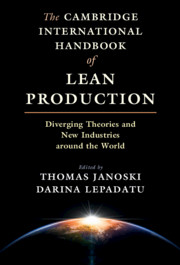 The Cambridge International Handbook of Lean Production
The Cambridge International Handbook of Lean Production Book contents
- The Cambridge International Handbook of Lean Production
- The Cambridge International Handbook of Lean Production
- Copyright page
- Dedication
- Contents
- Tables
- Figures and Sidebars
- Preface
- Acknowledgments
- Contributors
- Abbreviations
- 1 Lean Production as the Dominant Division of Labor
- Part I Theories of Lean Production
- Part II Lean Production across Industries
- Part III Lean Production Around the World
- 17 Lean in Europe and the USA – A New Dominant Division of Labour?
- 18 The Development and Diffusion of the Hyundai Production System
- 19 Transferring Lean to the United States
- 20 Disseminating Lean across the UK: A Personal Reflection
- 21 Lean Production in Germany
- 22 Tricolore
- 23 Lean Production in China: A Case Study of the Automobile Industry
- 24 Lean Production in India and Australia
- 25 The Four Stages of Lean in Mexico
- 26 Lean Production in Post-Communist Europe
- Name Index
- Subject Index
- References
24 - Lean Production in India and Australia
from Part III - Lean Production Around the World
Published online by Cambridge University Press: 11 March 2021
- The Cambridge International Handbook of Lean Production
- The Cambridge International Handbook of Lean Production
- Copyright page
- Dedication
- Contents
- Tables
- Figures and Sidebars
- Preface
- Acknowledgments
- Contributors
- Abbreviations
- 1 Lean Production as the Dominant Division of Labor
- Part I Theories of Lean Production
- Part II Lean Production across Industries
- Part III Lean Production Around the World
- 17 Lean in Europe and the USA – A New Dominant Division of Labour?
- 18 The Development and Diffusion of the Hyundai Production System
- 19 Transferring Lean to the United States
- 20 Disseminating Lean across the UK: A Personal Reflection
- 21 Lean Production in Germany
- 22 Tricolore
- 23 Lean Production in China: A Case Study of the Automobile Industry
- 24 Lean Production in India and Australia
- 25 The Four Stages of Lean in Mexico
- 26 Lean Production in Post-Communist Europe
- Name Index
- Subject Index
- References
Summary
Lean thinking is hailed as one of the most influential management ideas of the last fifty years, with the renowned Toyota Production System (TPS) of Toyota Motor Corporation (TMC 2001) Japan widely acknowledged as its precursor (Stanton, Gough, Ballardie, Bartram, Bamber, and Sohal 2014). Despite some recent safety-related setbacks, Toyota continues to be the standard-bearer of lean thinking, and the Toyota Production System enjoys an almost cult-like status. The TPS/lean has contributed in recent years to the introduction of several management practices including job rotation, standardization, quality management, broadened responsibilities and the “Just-in-Time” system. Besides being extensively imitated by all other leading motor vehicle producers globally, lean’s current applications span several sectors, such as banking, call centers, health care, educational institutions, government agencies and other elements of the services sector (Bamber, Stanton, Bartram, and Ballardie 2014).
- Type
- Chapter
- Information
- The Cambridge International Handbook of Lean ProductionDiverging Theories and New Industries around the World, pp. 573 - 594Publisher: Cambridge University PressPrint publication year: 2021


